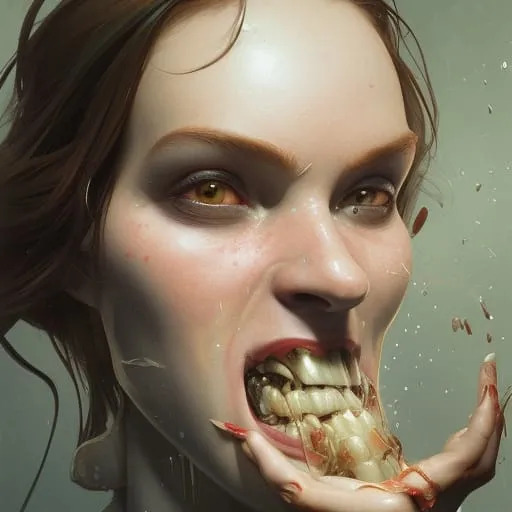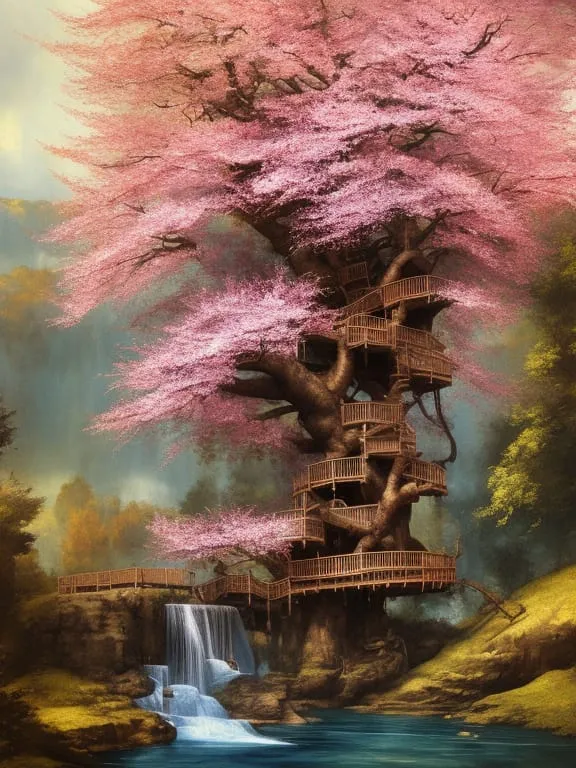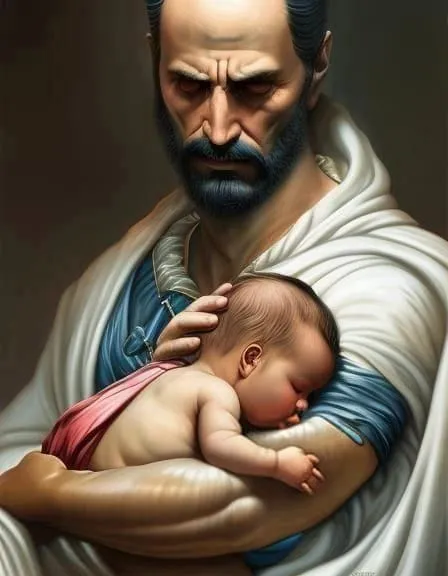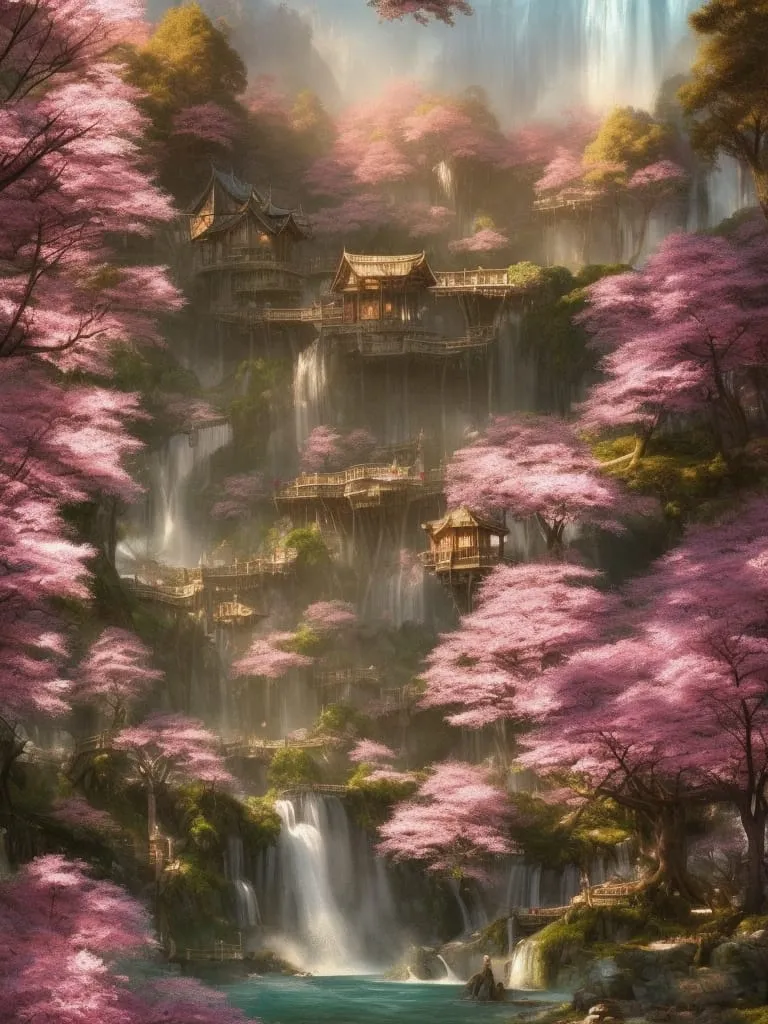
Above: Charles Moffat's "Wood Elf Village Hidden in Cherry Falls", 2023.
The Ease of Creating Digital Artwork with AI Technology:
Empowering Artists and Non-Artists Alike
By Chaz G. T. Patto - July 2023.
Artificial Intelligence (AI) technology has revolutionized the way we create digital artwork, making it more accessible and user-friendly for artists and non-artists alike. With the help of AI-powered tools and software, individuals can now explore their creativity and bring their artistic visions to life with ease. This article delves into how AI technology has simplified the process of creating digital artwork and highlights the case of an individual interested in portraying a woman wearing hearing aids.
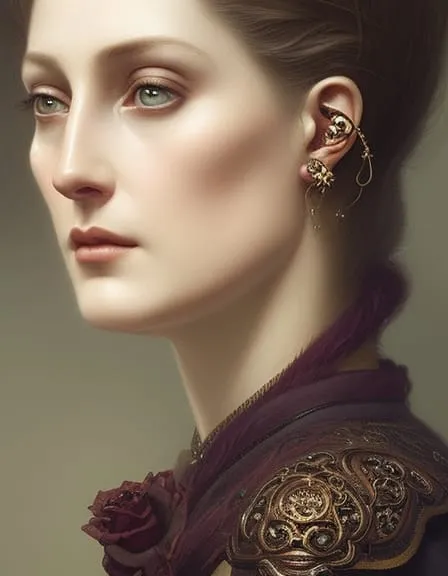
Right: Charles Moffat's "Steampunk Hearing Aid", 2023.
The Rise of AI in Art
AI technology has made significant strides in recent years, enabling innovative applications in various industries. In the art world, AI has become a powerful tool for generating, enhancing, and transforming digital artwork. From AI-powered painting tools to style transfer algorithms, artists can now leverage AI to augment their creative process and push artistic boundaries.
Accessibility and User-Friendliness
One of the key advantages of AI technology in creating digital artwork is its accessibility and user-friendliness. AI-powered software, such as digital painting applications, offer intuitive interfaces and a wide range of tools that simplify the artistic process. These tools often include features like automatic brushstroke suggestions, color palette recommendations, and perspective correction, empowering both seasoned artists and beginners to explore their creativity without steep learning curves.
Example: Portraying a Woman Wearing Hearing Aids:
To illustrate the possibilities of AI-assisted digital artwork creation, let's consider the case of an individual who wishes to create artworks depicting a woman wearing hearing aids. With AI technology, they can utilize various tools and techniques to bring their artistic vision to fruition:
Digital Painting Applications
AI-powered digital painting applications provide a vast array of brushes, textures, and color options. The artist can select a brush that closely resembles the texture of the canvas they desire and start painting a portrait of the woman. The software's user-friendly interface allows for precise control over brush strokes, enabling the artist to capture intricate details such as the shape of the hearing aids and the woman's facial features.
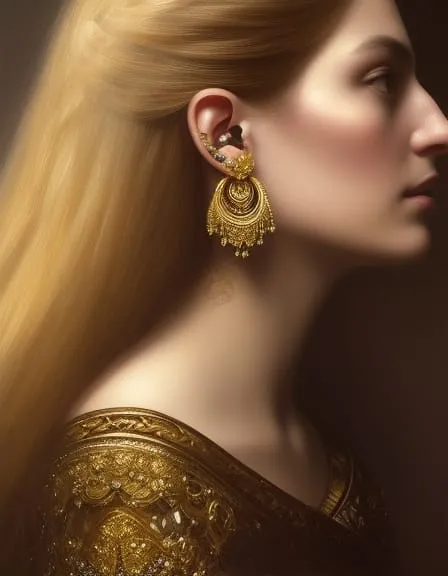
Right: Charles Moffat's "Decorative Hearing Aid", 2023.
Image Manipulation and Editing
AI-based image manipulation tools allow artists to modify and enhance their artwork effortlessly. By using AI algorithms, the artist can refine and adjust elements within the painting, such as color saturation, contrast, and lighting. This enables them to create a visually striking composition, highlighting the woman's facial expressions and the presence of the hearing aids.
Collaboration with AI Style Transfer
The artist may also choose to experiment with AI style transfer algorithms to infuse their artwork with a specific aesthetic. By combining the original portrait with a style derived from other artworks or photographs, the artist can achieve a unique fusion of artistic elements that complements their depiction of the woman wearing hearing aids. This collaboration between the artist's vision and AI-generated styles offers endless possibilities for creating compelling and thought-provoking artwork.
AI technology has opened up exciting avenues for creating digital artwork, allowing artists and non-artists to explore their creativity and bring their visions to life. The user-friendly interfaces and powerful AI algorithms of digital painting applications enable individuals to overcome technical barriers and effortlessly create artworks. Through the example of an artist portraying a woman wearing hearing aids, we witness how AI-assisted tools empower artists to express their unique perspectives and contribute to a more diverse and inclusive artistic landscape. As AI technology continues to evolve, we can expect even greater possibilities for artistic expression and innovation in the world of digital art.
Technology as an Artistic Tool:
Embracing Cyborgian Theory in Digital Art Creation
By Chaz G. T. Patto - July 2023.
The integration of technology, particularly computers and AI, in the process of creating artwork has sparked debates regarding the nature of artistic expression and the evolving role of artists. In this article, we argue that using technology to create artwork is simply an extension of the long-standing tradition of utilizing tools such as paintbrushes or pens. Drawing upon Cyborgian Theory, which explores the relationship between humans and technology, we contend that embracing technology as an artistic tool represents a natural progression towards a more cyborg-like existence.
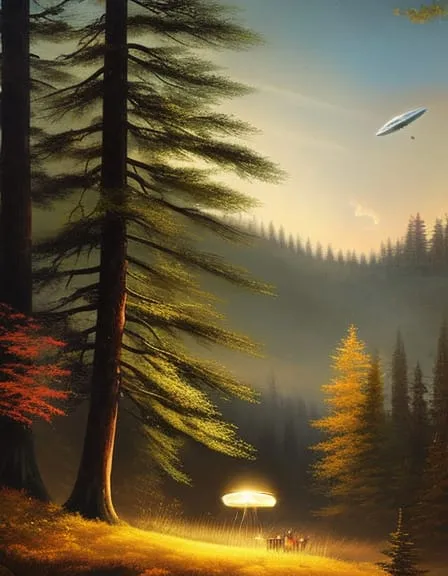
Right: Charles Moffat's "The Signal", 2023.
Artistic Tools: From Traditional to Technological
Throughout history, artists have relied on various tools to bring their creative visions to life. From the earliest cave paintings to Renaissance masterpieces, artists utilized brushes, chisels, and other physical instruments to manipulate their chosen medium. These tools became extensions of their hands and minds, allowing for the expression of ideas and emotions.
In the contemporary era, technology has emerged as a new set of tools for artistic creation. Computers, digital painting applications, and AI algorithms offer artists novel ways to explore their creativity, facilitating experimentation, collaboration, and enhanced precision. However, despite their digital nature, these tools serve the same purpose as traditional instruments, acting as vehicles for artistic expression and vision.
Cyborgian Theory and the Evolution of Artistic Expression
Cyborgian Theory, developed by scholars such as Donna Haraway, examines the symbiotic relationship between humans and technology. According to this theory, individuals can be considered "cyborgs" when they incorporate technological devices into their everyday lives, such as glasses, hearing aids, or even smartphones.
Applying Cyborgian Theory to the realm of art, we can view the integration of technology, including computers and AI, as a natural extension of the human artist's experience. Just as glasses enhance vision or hearing aids improve auditory perception, computers and AI can enhance an artist's creative capabilities and extend their artistic reach. By leveraging these tools, artists tap into the potential of merging human creativity with technological prowess, blurring the boundaries between the organic and the artificial.
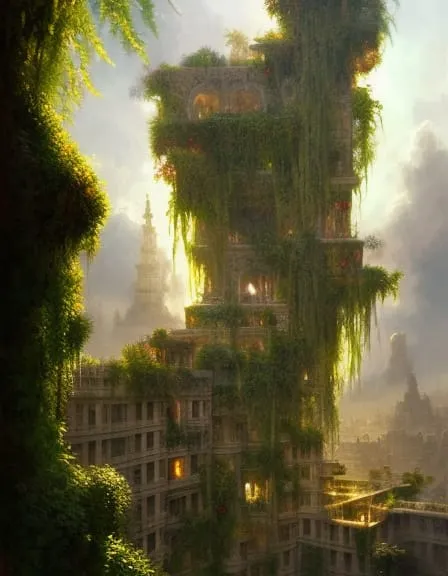
Right: Charles Moffat's "Hanging Gardens of Babylon", 2023.
Embracing the Cyborgian Perspective in Art Creation
By embracing technology as an artistic tool, artists align themselves with the principles of Cyborgian Theory. Utilizing computers and AI to create artwork does not diminish the role of human creativity but amplifies it. These tools enable artists to explore new possibilities, transcend traditional constraints, and engage in multidimensional forms of expression.
Additionally, adopting a cyborg-like approach challenges conventional notions of the artist's relationship with the medium. The process becomes a fusion of the artist's imagination, skill, and technological capabilities, leading to new and innovative forms of artistic creation. This embrace of technology fosters an evolution in artistic expression, nurturing a more inclusive and expansive artistic landscape.
Incorporating technology, including computers and AI, into the creation of artwork is not a departure from traditional artistic practices but an extension of them. Just as artists have historically utilized tools like brushes and pens to express their creativity, the integration of technology represents a natural progression in the evolution of artistic tools.
Drawing upon Cyborgian Theory, we can perceive this integration as a step towards a more cyborg-like existence, where artists harness the power of technology to expand their creative horizons. By embracing this perspective, we celebrate the synergy between human creativity and technological innovation, ultimately enhancing the rich tapestry of artistic expression.
The Artist's Imagination: The Ultimate Tool in Artistic Creation
By Chaz G. T. Patto - July 2023.
Artistic creation is an inherently human endeavor that revolves around the imaginative power of the artist. While various tools and technologies, including AI, have expanded the possibilities of artistic expression, this essay argues that it is ultimately the artist's imagination that remains their greatest tool. The imagination serves as the wellspring of ideas, concepts, and visions, shaping the artistic process and imbuing artworks with depth, meaning, and individuality.
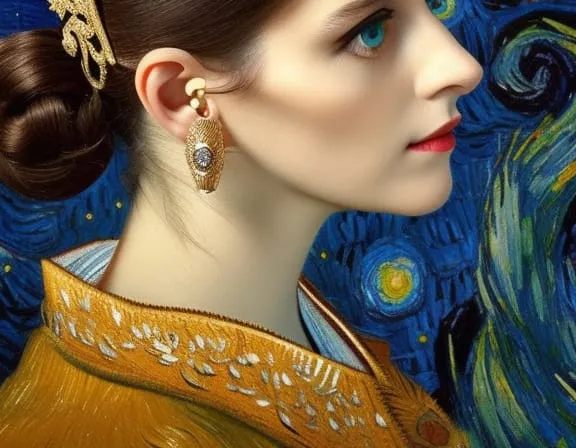
Right: Charles Moffat's "Muse with Gold Hearing Aid", 2023.
The Boundless Realm of Imagination
Imagination is the wellspring of creativity, allowing artists to transcend the confines of reality and delve into the depths of their inner worlds. It is the realm where ideas are conceived, possibilities are explored, and visions are born. Through the power of imagination, artists can conceptualize unique perspectives, narratives, and emotions that evoke profound responses in viewers.
Unleashing Creativity
Tools and technologies, including AI, undoubtedly offer new avenues for artistic expression. However, their impact pales in comparison to the boundless potential of the artist's imagination. The artist's mind is capable of envisioning entirely new worlds, characters, and concepts that transcend the limitations of the physical tools they employ.
The imagination serves as the catalyst that drives the artistic process. It fuels experimentation, encourages risk-taking, and empowers artists to push the boundaries of their craft. It allows them to break free from conventions, challenge established norms, and create truly original and groundbreaking works of art.
Imagination as a Transformative Force
Artists throughout history have harnessed the power of imagination to inspire change, provoke thought, and challenge societal norms. From the evocative brushstrokes of Van Gogh to the surrealist visions of Salvador Dalí, it is the artist's imagination that has enabled them to offer fresh perspectives and reshape the artistic landscape.
While tools and technologies may assist in the technical execution of an artwork, it is the artist's imaginative choices that define its essence. The artist's unique vision and personal interpretation infuse their work with meaning, symbolism, and emotional depth. It is through the artist's imaginative lens that the world is refracted, transforming the ordinary into the extraordinary.
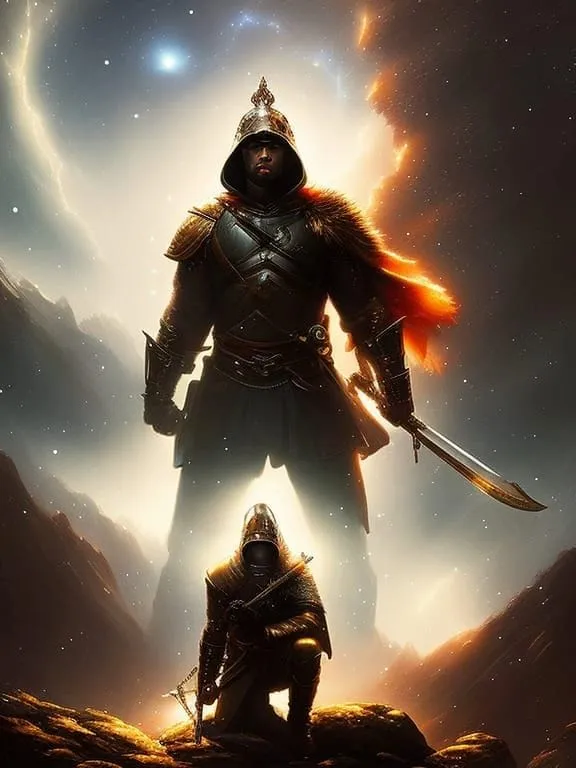
Right: Charles Moffat's "Servant of the Star God", 2023.
Embracing the Intangible
The intangible nature of imagination gives artists unparalleled freedom and flexibility. It is not confined by the limitations of physical tools or the capabilities of AI algorithms. The artist's imagination has the power to transcend the present moment, drawing inspiration from diverse sources, combining disparate elements, and fusing ideas from various disciplines.
Artistic Evolution
Throughout history, artists have embraced new tools and technologies, expanding the boundaries of artistic expression. From the advent of oil paints to the introduction of digital media, these tools have provided fresh avenues for artists to channel their imagination. However, the core essence of artistic creation remains rooted in the artist's ability to imagine and envision.
While the utilization of tools and technologies, including AI, undoubtedly enhances the artistic process, it is the artist's imagination that remains their most powerful tool. Imagination breathes life into artworks, enabling artists to transcend reality, evoke emotions, and inspire change. It is the wellspring of creativity, the driving force behind artistic evolution, and the key to forging a unique artistic identity. As technology advances, the artist's imagination will continue to reign supreme, shaping the artistic landscape and captivating audiences through its limitless potential.
Navigating the Ethical and Legal Implications of AI Art
By Chaz G. T. Patto - July 2023.
The emergence of AI Art has raised profound ethical and legal considerations that demand careful examination. As artificial intelligence algorithms become increasingly capable of generating artworks, questions arise regarding issues such as authorship, intellectual property, bias, and the potential consequences of AI-generated content. This essay explores the ethical and legal implications of AI Art and the challenges we face in navigating this rapidly evolving landscape.
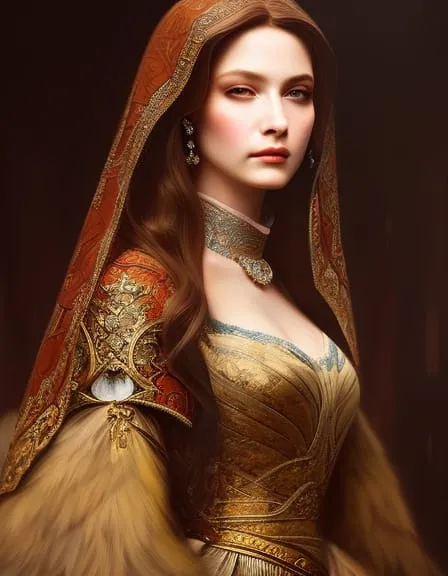
Right: Charles Moffat's "Princess", 2023.
Ethical Concerns
Authorship and Authenticity
AI-generated artworks blur the lines of authorship, challenging traditional notions of artistic creation. Determining the true author of an AI-generated piece becomes complex, as both the artist and the AI system contribute to the final output. This raises questions about the ownership of creative works and the recognition of human contributions.
Intellectual Property
AI algorithms can be trained on vast datasets, potentially including copyrighted material. This raises concerns about the infringement of intellectual property rights when AI systems generate artworks that incorporate copyrighted elements. Clarifying the legal frameworks surrounding ownership and copyright becomes essential in ensuring fair attribution and protecting the rights of artists and original creators.
Bias and Representation
AI algorithms are only as unbiased as the data they are trained on. If the training data contains biases, such as societal prejudices or cultural stereotypes, the AI-generated artworks may perpetuate or amplify such biases. This highlights the need for transparency, diversity, and ethical considerations when selecting and curating datasets used in AI Art.
Legal Considerations
Copyright and Attribution
The question of copyright ownership in AI-generated artworks is a complex legal challenge. Current copyright laws generally attribute authorship to human creators. However, the collaborative nature of AI Art blurs this distinction, necessitating legal frameworks that account for the unique contributions of both human artists and AI systems.
Intellectual Property Infringement
AI algorithms capable of reproducing existing artworks raise concerns about the infringement of intellectual property rights. Artists and organizations must navigate the legal landscape to ensure that AI-generated artworks do not violate copyright laws or plagiarize existing creations.
Liability and Accountability
AI algorithms operate based on complex computational processes, making it difficult to pinpoint responsibility in cases of infringement, controversial content, or potential harm caused by AI-generated artworks. Determining liability and establishing accountability frameworks for AI-generated art remains a legal challenge that requires careful consideration.
Ethical and Legal Frameworks
Addressing the ethical and legal implications of AI Art requires the collaboration of artists, policymakers, legal experts, and technology developers. Establishing clear guidelines, codes of conduct, and industry standards can help ensure ethical practices and responsible use of AI in artistic creation. Transparent documentation, explainability of AI algorithms, and disclosure of data sources are crucial steps toward fostering ethical and accountable AI Art practices.
The rise of AI Art brings both exciting possibilities and complex ethical and legal challenges. To harness the transformative potential of AI in art creation, it is crucial to address questions of authorship, intellectual property, bias, and accountability. Ethical guidelines, legal frameworks, and interdisciplinary collaborations are vital for promoting responsible AI Art practices, protecting the rights of creators, and fostering an inclusive and culturally sensitive artistic landscape.
By navigating these ethical and legal considerations with care and foresight, we can maximize the benefits of AI Art while safeguarding the integrity of artistic expression and the well-being of society as a whole.
|


